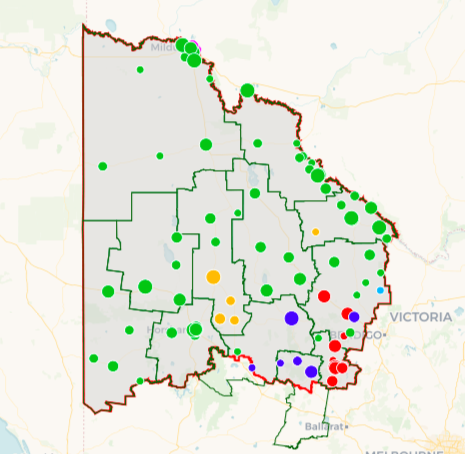It looks like the Nationals have retained the seat of Mallee in north-western Victoria, but the race was remarkably wide open, with no candidate polling over 30% and six different candidates topping the poll in at least one booth.
Nationals candidate Anne Webster polled 28.7%, with the Liberal Party’s Serge Petrovich second on 18.4%. Labor’s Carole Hart is on 15.5%, with two independents (Jason Modica and Ray Kingston) polling just over 9%.
The two-candidate-preferred count is between the Nationals and Labor candidates, and shows a clear win for Webster, with 66.4%.
There appears to be a small chance that either of the independents could overtake Labor and then make it to the final count. I won’t go into detail about this possibility but Kevin Bonham has considered this prospect.
After the fold I have some maps showing aspects of the Mallee result, and I’ve analysed the geographic shape of this election result.
There are three layers of voting data in this map.
The first layer shows which candidate topped the primary vote in each booth. The first six candidates each won a booth, including the Shooters, Fishers and Farmers candidate who managed to win a small booth on the eastern edge of the electorate.
Of course, we don’t use a first-past-the-post system so I tried to come up with a slightly different map which gave a sense of whether the Coalition candidates or the other challengers polled a higher total vote, by combining the Labor vote and those for the two stronger independents.
Finally there’s a third map which shows the combined primary vote swing against the Liberal and Nationals candidates since 2016 (when there was a Nationals candidate in most of the seat except for an area in the south-east which was previously in Wannon).
Unsurprisingly the Nationals topped the primary vote in most parts of the seat. Jason Modica topped the poll in most of the booths in the Mildura open area, while Ray Kingston came first in Warracknabeal and a number of booths immediately to the south. Labor came first in a series of booths in the south-east of the seat, with the Liberals also winning some booths in this area.
Another way to look at the diversity of voting patterns is to break down the vote totals by subarea. I broke up the booths of Mallee into five subareas in my pre-election guide: north-east, south-east, south-west, central and Mildura.
| Subarea | LIB | Modica | NAT | ALP | Kingston |
| Mildura | 14.0 | 26.0 | 27.4 | 12.1 | 4.8 |
| North-East | 13.7 | 3.8 | 34.2 | 11.6 | 13.4 |
| Central | 12.6 | 2.7 | 37.9 | 13.3 | 19.1 |
| South-East | 24.5 | 1.9 | 19.3 | 28.5 | 3.9 |
| South-West | 17.5 | 1.8 | 29.5 | 15.0 | 16.5 |
The top two candidates were different in almost every area. The Nationals topped the poll in four areas, only falling short in the south-east, which was mostly transferred in from areas previously covered by the Liberal Party. Labor came first in the south-east, followed by the Liberals.
Jason Modica almost outpolled the Nationals in the Mildura areas, but performed very poorly in the rest of the seat. Ray Kingston had a more evenly distributed vote, peaking in the centre of the seat, where he came second. The Liberal Party came second to the Nationals in the Coalition’s stronger areas in the north-east and south-west.
Finally, it’s worth looking at which areas saw the biggest drop in the Coalition vote. The two-candidate-preferred figure masks how much support was lost to the two independents, so instead I’ve looked at a combined primary vote swing for the Nationals and Liberal candidates. It looks like the worst swings were in the north-east (along the Murray) and the south-west, with some pretty big swings in the centre of the seat.




Wow!
This is a text book case for the way preferential voting works. it really will come down to the way the preferences all go at the micro level.
Now I could be completely wrong here but i am guessing that when compared with the nationals, 60% of the shooters preferences will end with the independent, about 80% of the ALP and Green will land with the independents and say 30% of the UAP too, with say 30% of all the other minors. if we also assume 80% of all independents will land with the last indie standing. So if the ALP drops our early then it is a three way between libs, nats and whichever independent is ahead. It is still ot likely to be enough but what a complex ballot.
Comments are closed.